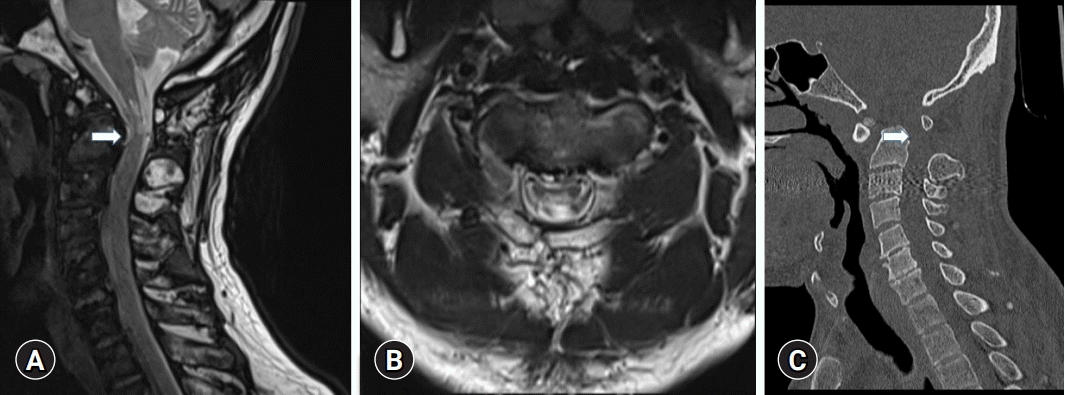1. Hong JT, Kim IS, Lee HJ, Park JH, Hur JW, Lee JB, et al. Evaluation and surgical planning for craniovertebral junction deformity. Neurospine. 2020; 17:554–67.
2. Frempong-Boadu AK, Faunce WA, Fessler RG. Endoscopically assisted transoral-transpharyngeal approach to the craniovertebral junction. Neurosurgery. 2002; 51(5 Suppl):S60–6.
3. Mummaneni PV, Haid RW. Transoral odontoidectomy. Neurosurgery. 2005; 56:1045–50.
4. Shaha AR, Johnson R, Miller J, Milhorat T. Transoral-transpharyngeal approach to the upper cervical vertebrae. Am J Surg. 1993; 166:336–40.
5. Silveira-Bertazzo G, Manjila S, London NR Jr, Prevedello DM. Focused endoscopic endonasal craniocervical junction approach for resection of retro-odontoid lesions: surgical techniques and nuances. Acta Neurochir (Wien). 2020; 162:1275–80.
6. Grose E, Moldovan ID, Kilty S, Agbi C, Lamothe A, Alkherayf F. Clinical outcomes of endoscopic endonasal odontoidectomy: a single-center experience. World Neurosurg. 2020; 137:e406–15.
7. Signorelli F, Olivi A, De Giorgio F, Pascali VL, Visocchi M. A 360° approach to the craniovertebral junction in a cadaveric laboratory setting: historical insights, current, and future perspectives in a comparative study. World Neurosurg. 2020; 140:564–73.
8. Visocchi M, Signorelli F, Liao C, Rigante M, Ciappetta P, Barbagallo G, et al. Transoral versus transnasal approach for craniovertebral junction pathologies: which route is better? Acta Neurochir Suppl. 2019; 125:181–6.
9. Crockard HA. Transoral surgery: some lessons learned. Br J Neurosurg. 1995; 9:283–93.
10. Alfieri A, Jho HD, Tschabitscher M. Endoscopic endonasal approach to the ventral cranio-cervical junction: anatomical study. Acta Neurochir (Wien). 2002; 144:219–25.
11. Kassam AB, Snyderman C, Gardner P, Carrau R, Spiro R. The expanded endonasal approach: a fully endoscopic transnasal approach and resection of the odontoid process: technical case report. Neurosurgery. 2005; 57(1 Suppl):E213.
12. Nayak JV, Gardner PA, Vescan AD, Carrau RL, Kassam AB, Snyderman CH. Experience with the expanded endonasal approach for resection of the odontoid process in rheumatoid disease. Am J Rhinol. 2007; 21:601–6.
13. Shkarubo AN, Chernov I, Andreev DN, Nikolenko VN, Chmutin KG, Sinelnikov MY. Expanded endoscopic transnasal odontoidectomy and posterior stabilization: a combined approach. J Neurosurg Sci. 2022; 66:551–9.
14. Yu Y, Wang X, Zhang X, Hu F, Gu Y, Xie T, et al. Endoscopic transnasal odontoidectomy to treat basilar invagination with congenital osseous malformations. Eur Spine J. 2013; 22:1127–36.
15. Visocchi M, Iacopino DG, Signorelli F, Olivi A, Maugeri R. Walk the line: the surgical highways to the craniovertebral junction in endoscopic approaches: a historical perspective. World Neurosurg. 2018; 110:544–57.
16. Shriver MF, Kshettry VR, Sindwani R, Woodard T, Benzel EC, Recinos PF. Transoral and transnasal odontoidectomy complications: a systematic review and meta-analysis. Clin Neurol Neurosurg. 2016; 148:121–9.








 PDF
PDF Citation
Citation Print
Print



 XML Download
XML Download